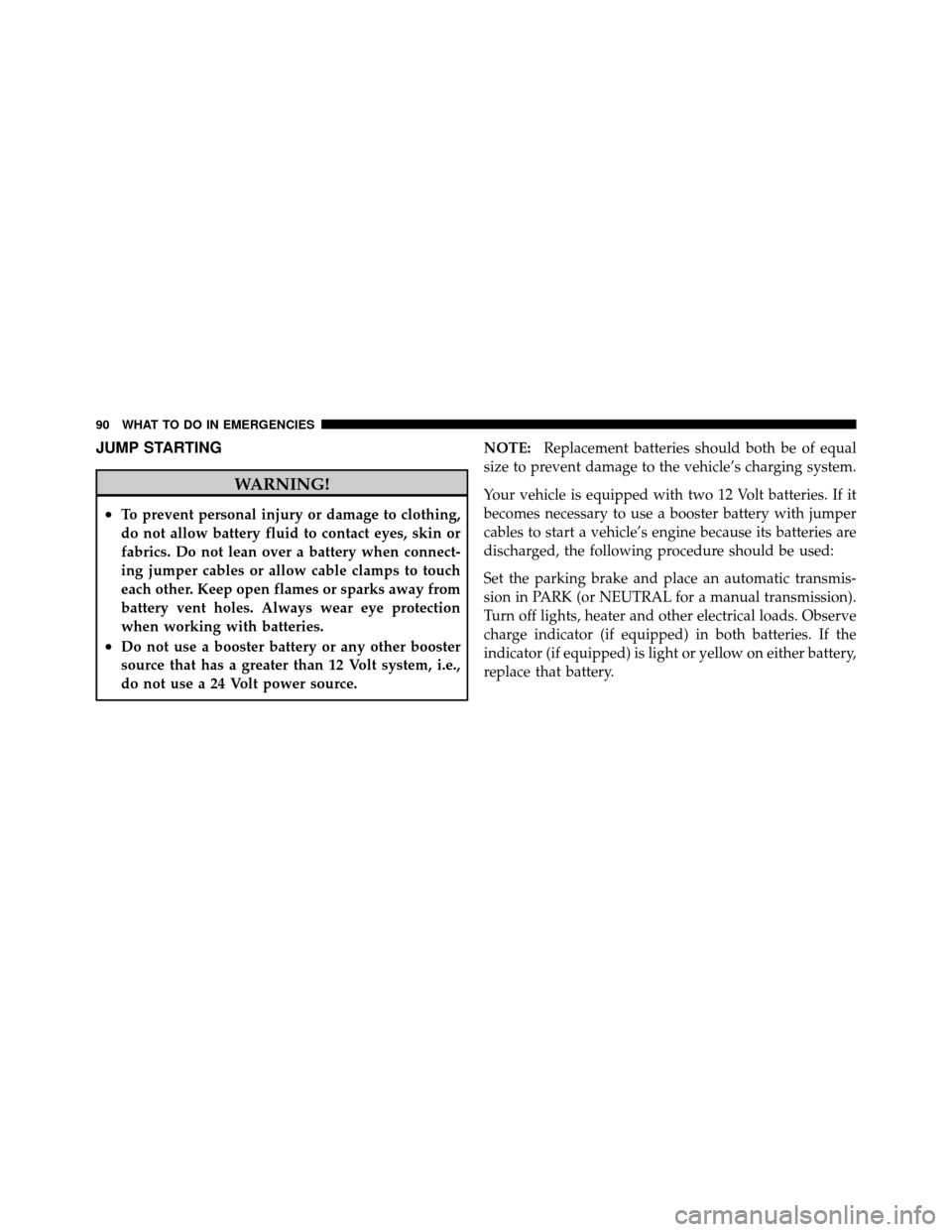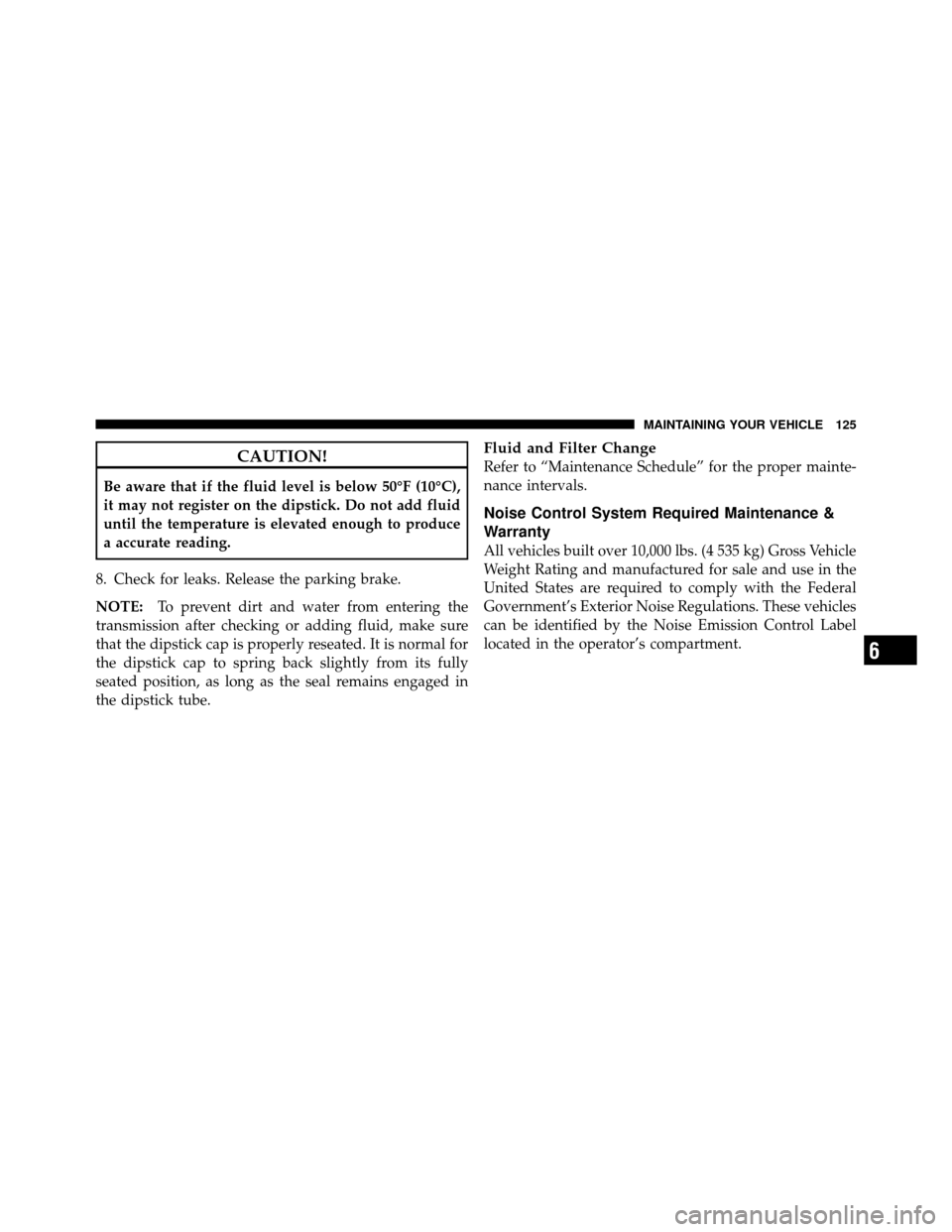2011 Ram 3500 brake light
[x] Cancel search: brake lightPage 47 of 170

CAUTION!
Do not crank engine for more than 15 seconds at a
time or starter motor damage may result. Turn the
ignition switch to the OFF position and wait at least
two minutes for the starter to cool before repeating
start procedure.
5. When the engine starts, release the key fob.
6. Check to see that there is oil pressure.
7. Release the parking brake.
Starting Procedure – Engine Manifold Air
Temperature 0°F to 66°F (–18°C to 19°C)
NOTE: The temperature displayed in the Electronic
Vehicle Information Center (EVIC) does not necessarily
reflect the engine manifold air temperature. Refer to “Electronic Vehicle Information Center (EVIC)” in “Un-
derstanding Your Instrument Panel” for further informa-
tion. When engine temperatures fall below 66°F (19°C)
the “Wait To Start Light” will remain on indicating the
intake manifold heater system is active.
Follow the steps in the “Normal Starting” procedure
except:
1. The “Wait To Start Light” will remain on for a period
of time (length of time depends on engine temperature).
CAUTION!
If the “Water in Fuel Indicator Light” remains on, DO
NOT START engine before you drain the water from
the fuel filter to avoid engine damage. Refer to
“Maintenance Procedures/Draining Fuel/Water Sepa-
rator Filter” in “Maintaining Your Vehicle” for fur-
ther information.
46 STARTING AND OPERATING
Page 48 of 170

2. After the “Wait To Start Light” goes off, turn the
ignition switch to the START position. Do not press the
accelerator during starting.
CAUTION!
Do not crank engine for more than 15 seconds at a
time or starter motor damage may result. Turn the
ignition switch to the OFF position and wait at least
two minutes for the starter to cool before repeating
start procedure.
3. After engine start-up, check to see that there is oil
pressure.
4. Allow the engine to idle about three minutes until the
manifold heaters have completed the post-heat cycle.
5. Release the parking brake and drive. NOTE:
•Engine idle speed will automatically increase to 1,000
RPM at low coolant temperatures to improve engine
warm-up.
•If the engine stalls, or if the ignition switch is left ON
for more than two minutes after the “Wait To Start
Light” goes out, reset the grid heaters by turning the
ignition switch to the OFF position for at least five
seconds and then back ON. Repeat steps 1 through 5 of
“Starting Procedure – Engine Manifold Air Tempera-
ture Below 66°F (19°C).”
Starting Procedure – Engine Manifold Air
Temperature Below 0°F (-18°C)
In extremely cold weather below 0°F (-18°C) it may be
beneficial to cycle the manifold heaters twice before
attempting to start the engine. This can be accomplished
by turning the ignition OFF for at least five seconds and
then back ON after the “Wait To Start Light” has turned
4
STARTING AND OPERATING 47
Page 91 of 170

JUMP STARTING
WARNING!
•To prevent personal injury or damage to clothing,
do not allow battery fluid to contact eyes, skin or
fabrics. Do not lean over a battery when connect-
ing jumper cables or allow cable clamps to touch
each other. Keep open flames or sparks away from
battery vent holes. Always wear eye protection
when working with batteries.
•Do not use a booster battery or any other booster
source that has a greater than 12 Volt system, i.e.,
do not use a 24 Volt power source.NOTE:
Replacement batteries should both be of equal
size to prevent damage to the vehicle’s charging system.
Your vehicle is equipped with two 12 Volt batteries. If it
becomes necessary to use a booster battery with jumper
cables to start a vehicle’s engine because its batteries are
discharged, the following procedure should be used:
Set the parking brake and place an automatic transmis-
sion in PARK (or NEUTRAL for a manual transmission).
Turn off lights, heater and other electrical loads. Observe
charge indicator (if equipped) in both batteries. If the
indicator (if equipped) is light or yellow on either battery,
replace that battery.
90 WHAT TO DO IN EMERGENCIES
Page 120 of 170

•Keep the front of the radiator clean. If your vehicle is
equipped with air conditioning, keep the front of the
condenser clean.
•Do not change the thermostat for Summer or Winter
operation. If replacement is ever necessary, install
ONLY the correct type thermostat. Other designs may
result in unsatisfactory cooling performance, poor gas
mileage, and increased emissions.
Charge Air Cooler – Inter-Cooler
The charge air cooler is positioned between the radiator
and the air conditioner condenser. Air enters the engine
through the air cleaner and passes through the turbo-
charger, where it is pressurized. This pressurized air
rapidly reaches high temperature. The air is then directed
through a hose to the charge air cooler and through
another hose to the intake manifold of the engine. The air
entering the engine has been cooled by about 50° to 100°F
(10° to 38°C). This cooling process enables more efficient
burning of fuel resulting in fewer emissions.To guarantee optimum performance of the system, keep
the surfaces of the charge air cooler, condenser and
radiator clean and free of debris. Periodically check the
hoses leading to and from the charge air cooler for cracks
or loose clamps resulting in loss of pressure and reduced
engine performance.
Brake System
Brake Master Cylinder – Brake Fluid Level Check
The fluid level of the master cylinder should be checked
when performing under the hood service, or immedi-
ately if the “Brake System Warning Light” indicates
system failure.
The brake master cylinder has a translucent plastic
reservoir. On the outboard side of the reservoir, there is a
“MAX” mark and an “MIN” mark. The fluid level must
be kept within these two marks. Do not add fluid above
the full mark because leakage may occur at the cap.
6
MAINTAINING YOUR VEHICLE 119
Page 124 of 170

NOTE:If it is necessary to check the transmission below
the operating temperature, the fluid level should be
between the two “COLD” (lower) holes on the dipstick
with the fluid at approximately 70°F (21°C) (room tem-
perature). If the fluid level is correctly established at
room temperature, it should be between the “HOT”
(upper) reference holes when the transmission reaches
180°F (82°C). Remember it is best to check the level at the
normal operating temperature.
CAUTION!
Be aware that if the fluid temperature is below 50°F
(10°C) it may not register on the dipstick. Do not add
fluid until the temperature is elevated enough to
produce an accurate reading.
7. Check for leaks. Release parking brake. To prevent dirt and water from entering the transmission
after checking or replenishing fluid, make certain that the
dipstick cap is properly reseated. It is normal for the
dipstick cap to spring back slightly from its fully seated
position, as long as its seal remains engaged in the
dipstick tube.
Fluid Level Check – AS68RC (Chassis Cab Only)
Check the fluid level while the transmission is at normal
operating temperature. This occurs after at least 15 miles
(25 km) of driving. At normal operating temperature, the
fluid cannot be held comfortably between the fingertips.
To properly check the transmission fluid, the following
procedure must be used.
1. The vehicle must be on level ground.
2. Operate the engine at idle speed for a minimum of
60 seconds and normal operating temperature.
6
MAINTAINING YOUR VEHICLE 123
Page 126 of 170

CAUTION!
Be aware that if the fluid level is below 50°F (10°C),
it may not register on the dipstick. Do not add fluid
until the temperature is elevated enough to produce
a accurate reading.
8. Check for leaks. Release the parking brake.
NOTE: To prevent dirt and water from entering the
transmission after checking or adding fluid, make sure
that the dipstick cap is properly reseated. It is normal for
the dipstick cap to spring back slightly from its fully
seated position, as long as the seal remains engaged in
the dipstick tube.
Fluid and Filter Change
Refer to “Maintenance Schedule” for the proper mainte-
nance intervals.
Noise Control System Required Maintenance &
Warranty
All vehicles built over 10,000 lbs. (4 535 kg) Gross Vehicle
Weight Rating and manufactured for sale and use in the
United States are required to comply with the Federal
Government’s Exterior Noise Regulations. These vehicles
can be identified by the Noise Emission Control Label
located in the operator’s compartment.
6
MAINTAINING YOUR VEHICLE 125
Page 163 of 170

Adding Fuel............................ 83
Air Cleaner, Engine (Engine Air Cleaner
Filter) ............................. 102,126
Air Filter .............................. 102
Airbag Light ............................ 19
Antifreeze (Engine Coolant) .............. 114,115
Capacities ........................... 130
Disposal ............................ 117
Anti-Lock Warning Light ................... 19
Automatic Transmission .................... 68
Adding Fluid ......................... 122
Fluid Level Check ..................... 122
Fluid Type ........................ 122,133
Shifting .............................. 62
Axle Fluid ............................. 133
Battery ............................... 112
Blanket ........................... 51,113
Emergency Starting ..................... 90 Brake Fluid
............................ 133
Brake System ........................... 119
Fluid Check .......................... 119
Master Cylinder ....................... 119
Warning Light ......................... 14
Brake/Transmission Interlock ................ 61
Calibration, Compass ...................... 33
Capacities, Antifreeze (Engine Coolant) ........ 130
Capacities, Fluid ........................ 130
Caps, Filler Oil (Engine) .......................... 100
Radiator (Coolant Pressure) ............... 116
Charge Air Cooler ....................... 119
Check Engine Light (Malfunction Indicator
Light) ................................. 18
Compass .............................. 32
Compass Calibration ...................... 33
Compass Variance ........................ 33
162 INDEX
Page 165 of 170

Jump Starting......................... 90
Oil .............................. 98,131
Oil Filler Cap ......................... 100
Oil Synthetic ......................... 102
Runaway ............................. 81
Temperature Gauge ..................... 11
Exhaust Brake ........................... 58
Exhaust System ......................... 126
Filters Engine Fuel .......................... 104
Engine Oil ...................... 98,102,131
Flashers Turn Signal ........................... 11
Fluid, Brake ........................... 133
Fluid Capacities ......................... 130
Fluid Level Checks Brake ............................... 119
Manual Transmission ................... 121 Transfer Case
......................... 121
Fluids, Lubricants and Genuine Parts .......... 131
Fog Lights ............................. 19
Fuel ................................ 81,83
Adding .............................. 83
Conserving ........................... 30
Diesel .......................... 81,83,131
Filter ............................... 104
Gauge ............................... 11
Requirements .......................... 81
Saver Mode ........................... 30
Specifications .......................... 82
Tank Capacity ........................ 130
Gasoline (Fuel) Conserving ........................... 30
Gauges Coolant Temperature .................... 11
Fuel ................................ 11
164 INDEX